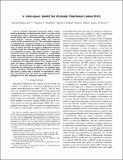A state-space model for dynamic functional connectivity
Author(s)
Chakravarty, Sourish; Threlkeld, Zachary D.; Bodien, Yelena G.; Edlow, Brian L.; Brown, Emery Neal
DownloadChakravartyEtAl_Asilomar2019_DFC[2].pdf (412.9Kb)
Additional downloads
Open Access Policy
Open Access Policy
Creative Commons Attribution-Noncommercial-Share Alike
Terms of use
Metadata
Show full item recordAbstract
Dynamic functional connectivity (DFC) analysis involves measuring correlated neural activity over time across multiple brain regions. Significant regional correlations among neural signals, such as those obtained from resting-state functional magnetic resonance imaging (fMRI), may represent neural circuits associated with rest. The conventional approach of estimating the correlation dynamics as a sequence of static correlations from sliding time-windows has statistical limitations. To address this issue, we propose a multivariate stochastic volatility model for estimating DFC inspired by recent work in econometrics research. This model assumes a state-space framework where the correlation dynamics of a multivariate normal observation sequence is governed by a positive-definite matrix-variate latent process. Using this statistical model within a sequential Bayesian estimation framework, we use blood oxygenation level dependent activity from multiple brain regions to estimate posterior distributions on the correlation trajectory. We demonstrate the utility of this DFC estimation framework by analyzing its performance on simulated data, and by estimating correlation dynamics in resting state fMRI data from a patient with a disorder of consciousness (DoC). Our work advances the state-of-the-art in DFC analysis and its principled use in DoC biomarker exploration.
Date issued
2020-03Department
Picower Institute for Learning and Memory; Massachusetts Institute of Technology. Department of Brain and Cognitive Sciences; Massachusetts Institute of Technology. Institute for Medical Engineering & ScienceJournal
(ACSSC 2019) 2019 Asilomar Conference on Signals, Systems, and Computers
Publisher
Institute of Electrical and Electronics Engineers (IEEE)
Citation
Chakravarty, Sourish et al. "A state-space model for dynamic functional connectivity." 53rd Asilomar Conference on Signals, Systems, and Computers, November 2019, Pacific Grove, CA, USA, Institute of Electrical and Electronics Engineers (IEEE), March 2020 © 2019 IEEE
Version: Author's final manuscript
ISBN
9781728143002
ISSN
2576-2303